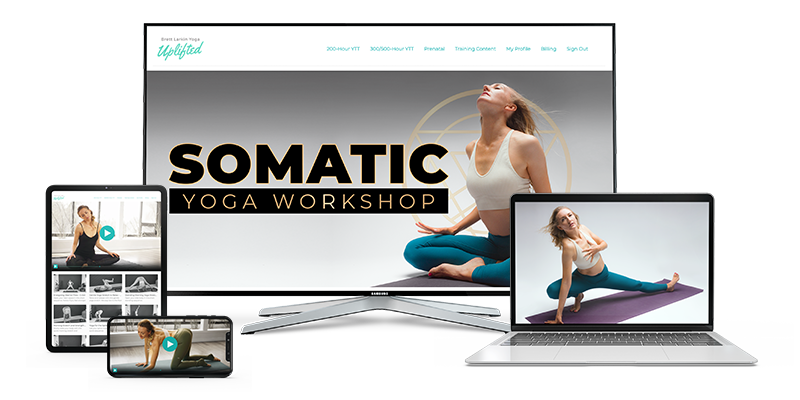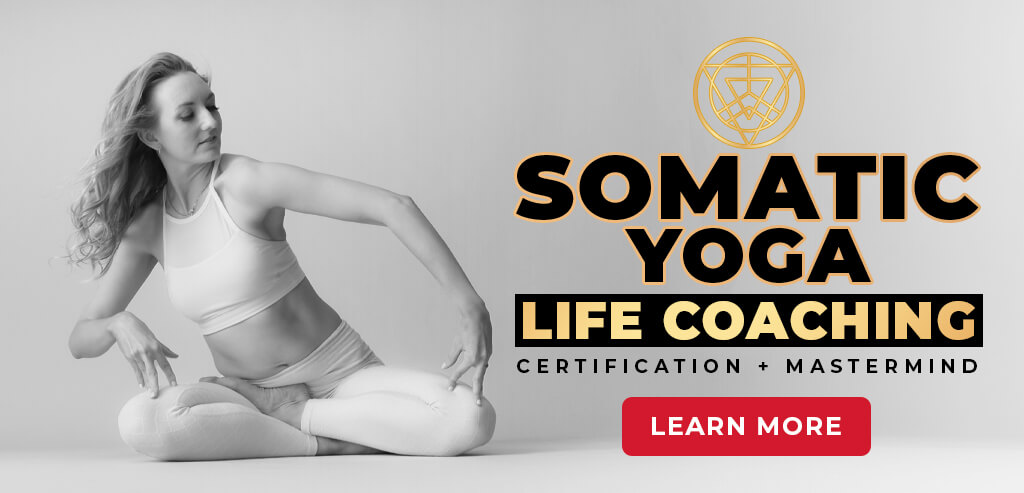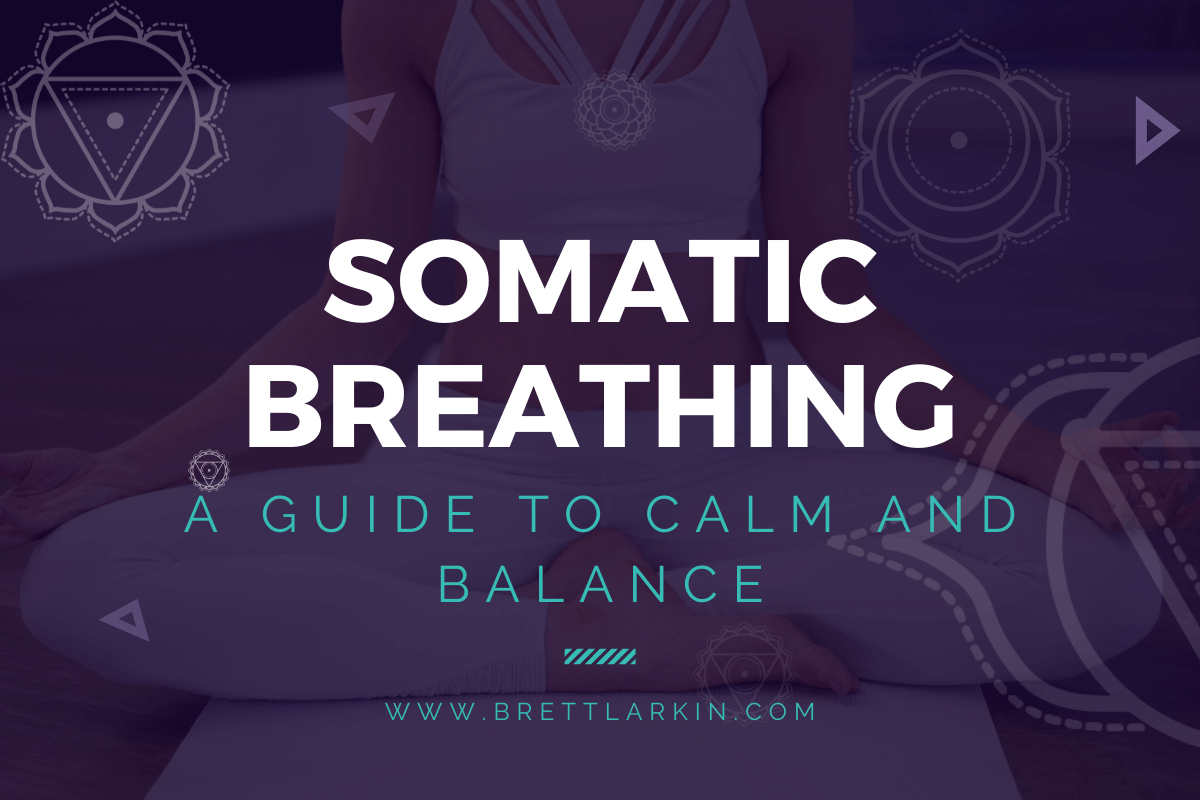When you get stressed, your body responds.
Your blood pressure might shoot up, your breath moves faster, and you might feel anxiety and stress in your body. Each inhalation and exhalation starts moving at a rapid pace, and your body fills with tension.
What if I told you that you could learn to control your breath and turn on your parasympathetic nervous system in those high-stress moments?
Somatic breathing is conscious breathing—and it’s a great way to ease physical tension, turn down the autonomic nervous system response and release trapped emotions.
You have more control over your own body than you think and it’s all starts with somatic practices and your own breath.
What Is Somatic Breathwork?
Somatic breathing is a therapeutic tool that involves mindful and conscious breathing techniques to enhance body awareness, provide stress reduction, and promote your mind body connection. It focuses on the intentional regulation of breath to activate the parasympathetic nervous system, which helps to calm the mind and body during stressful situations.
Think of somatic breathing as a reset button for your nervous system by being able to breathe diaphragmatically. When the rib cage is intentionally engaged, your body can take in more oxygen and you might even experience an altered state.
Imagine having the ability to soothe your mind and body with just a few deliberate breaths. Whether you’re feeling overwhelmed at work or struggling to fall asleep, somatic breathing can be your go-to tool for instant relief. It’s great for working on deeper issues too, like trauma and depression.
By focusing on your breath, you can shift your attention away from external stressors and create a sense of inner calm and balance. You can call back your energy and make space for deep rest. And your lungs will thank you!
This doesn’t require a lot of time or any special equipment—just a few minutes of focused breathwork techniques can make a significant difference on your stress level and mental health.
Techniques such as diaphragmatic breathing, where you breathe deeply into your belly, or the 4-7-8 breath, can help lower blood pressure, reduce anxiety, and improve your overall mood. Of course, there are many yoga breathing exercises that can become somatic breathing exercises too. All it takes is conscious awareness and a willingness to try.
Practicing somatic breathing exercises regularly not only helps manage stress but also enhances your resilience. When life happens, you’ll be better prepared to deal with it.
It’s a simple yet powerful way to tap into your body’s natural ability to heal and relax, making it an essential component of a holistic approach to self awareness and self improvement.
Who Somatic Breathwork Is For
Somatic breathwork is for anyone. It’s particularly beneficial for anyone dealing with chronic stress, anxiety, or emotional tension, as it provides tools to calm the nervous system and release stored emotions.
Athletes and physically active yogis can use somatic breathwork to improve their breathing efficiency, boost performance, and aid in recovery.
It’s also ideal for those with chronic pain or tension, offering a gentle approach to alleviate discomfort and promote relaxation.
Beginners to mindfulness and meditation practices will find somatic breathwork an accessible entry point, while seasoned practitioners can deepen their existing routines.
Whether you’re looking to manage everyday stress, enhance your yoga practice, or simply cultivate a greater sense of presence and awareness, somatic breathwork offers versatile and profound benefits for people from all walks of life.
Types Of Somatic Breathing Exercises
You’ve probably done a somatic breathing exercise without even knowing it! Anytime you focus your consciousness on your breath, you’re in a state of somatic healing.
There are many types of breathwork, but here are a few examples of different types of somatic breathing exercises:
Diaphragmatic Breathing
Also known as belly breathing, this exercise involves breathing deeply into the diaphragm rather than shallowly into the chest. In yoga, you can place your attention on your inhalation and exhalation.
To practice, place one hand on your chest and the other on your abdomen.
Inhale deeply through your nose, allowing your abdomen to rise while keeping your chest relatively still. Exhale slowly through your mouth, feeling your abdomen fall.
4-7-8 Breath
This calming breath technique involves inhaling for a count of 4, holding the breath for a count of 7, and exhaling slowly for a count of 8.
To practice, sit comfortably, close your eyes, and follow the count with each breath cycle. The 4-7-8 breath can quickly reduce stress, making it an excellent tool for high-stress moments or before bed.
Box Breathing
Box breathing, or square breathing, involves inhaling, holding the breath, exhaling, and holding again, each for an equal count, usually 4 seconds. Visualize breathing around the four sides of a box. Inhale for 4 counts, hold for 4, exhale for 4, and hold for 4 again. This technique helps improve focus and reduce stress by promoting a balanced and steady breath.
Alternate Nostril Breathing
This exercise balances the left and right hemispheres of the brain. Using your thumb and ring finger, close off one nostril and inhale deeply through the other. Switch nostrils and exhale through the opposite side. Continue this pattern, alternating nostrils with each breath cycle.
Whether you have a few minutes or a longer period to practice, these breathwork techniques offer accessible and effective ways to tap into the power of your breath with every inhalation and exhalation.
Somatic Breathwork Benefits
Most of us are in a continual state of holding our breath. The human respiratory system was not designed to be sitting in front of a screen all day, every day.
Instead, diaphragmatic breathing is what fosters well being. When you start a somatic breathwork practice, your life becomes more filled with vital energy.
Some of the things somatic breathwork can do for you include:
- Reduce stress and anxiety
- Lower blood pressure
- Promote relaxation and calm
- Enhance emotional regulation
- Improve focus and concentration
- Boost overall mood
- Increase somatic awareness
- Support better sleep quality
- Balance the autonomic nervous system
- Enhance respiratory efficiency
- Better mental health
- Decreased depression
- A natural sense of well being
How To Practice Somatic Breathing
Practicing somatic breathing is simple and can be done anywhere, anytime, just like breathwork. Learning from trained practicioners in group sessions can be supportive too. If you want to try on your own, here’s a step-by-step guide to help you get started:
- Find a Comfortable Position: Sit or lie down in a comfortable position. Make sure your spine is straight and your body is relaxed. I like to practice breathwork while sitting on a cushion so my rib cage has the space to fully engage.
- Close Your Eyes: Gently close your eyes to minimize distractions and bring your focus inward. You can even put on an eye mask. I love doing this!
- Place Your Hands: Place one hand on your chest and the other on your abdomen. This will help you feel the movement of your breath. You can also do a mudra or keep your hands at your sides. Feel into what your body prefers.
- Inhale Deeply: Inhale slowly and deeply through your nose, allowing your abdomen to rise while keeping your chest relatively still. Bring air down into your belly.
- Exhale Slowly: On your exhalation, exhale gently and fully through your mouth, feeling your abdomen fall. Try to make your exhale longer than your inhale.
- Maintain a Steady Rhythm: Continue this deep breathing pattern, maintaining a steady and smooth rhythm. Focus on the sensation of the breath entering and leaving your body. Let your brain turn off and allow your emotions to come up. Let your consciousness take the lead.
- Practice for 5-10 Minutes: Aim to practice for 5-10 minutes, gradually increasing the duration as you become more comfortable with the technique.
By following these steps, you can effectively practice somatic breathing and enjoy its numerous benefits, including reduced stress and improved overall well-being.
Experience My Somatic Yoga Workshop (usually $67) FREE!👇

How Often To Do Somatic Breathing
The frequency of somatic breathing exercises can vary based on your needs and goals. Here’s a clear schedule to help you incorporate somatic breathing into your routine:
| Purpose | Duration and Frequency | Benefits |
|---|---|---|
| For General Stress Management | 5-10 minutes, 1-2 times daily | Maintain a calm and balanced state |
| If You’re Dealing with High Stress or Anxiety | 10-15 minutes, 3 times a day | Manage anxiety and handle stressful moments |
| For Better Sleep | 10 minutes before bedtime | Relax mind and body, improve sleep quality |
| For Emotional Regulation | 5-minute sessions when emotionally overwhelmed | Regain control and maintain emotional balance |
| For Beginners | 3-5 minutes once a day, gradually increase | Build comfort and experience with the practice |
By following these guidelines, you can effectively integrate somatic breathing into your daily life and experience its numerous benefits. You might want to seek out a skilled practitioner who can teach you integrative mechanisms.
How To Use Somatic Breathing in Yoga
Really, you can add somatic breathwork to ANY pose. Start by focusing on your breath as you move through each pose, maintaining a steady, mindful breathing pattern.
Pay attention to the sensations in your body and use your breath to release any tension or tightness you encounter.
Inhale deeply to expand and create space, and exhale fully to relax and soften into the poses.
This conscious breathing can help you stay present and grounded, making your yoga practice more meditative and beneficial for both your body and mind. Like a form of intuitive exercise.
Here are some poses to start with:
Poses That Are Good for Somatic Breathing
- Child’s Pose (Balasana)
- Cat-Cow Pose (Marjaryasana–Bitilasana)
- Bridge Pose (Setu Bandhasana)
- Seated Forward Bend (Paschimottanasana)
- Legs-Up-The-Wall Pose (Viparita Karani)
- Reclining Bound Angle Pose (Supta Baddha Konasana)
- Corpse Pose (Savasana)
Focusing on your breath will enhance the benefits of any pose and support a deeper somatic experience. Every person is different, so you can choose the movement that pairs best with your breath. Honestly, this can create bigger shifts than therapy!
Take my feminine energy quiz to get a recommended practice for balancing YOUR feminine energy 👇
Common Questions About Somatic Release Breathwork
As you explore somatic release breathwork, you might have some questions about its safety and effectiveness. Here are answers to a few common questions:
Is somatic breathwork safe?
Yes, somatic breathwork is generally safe for most people. It involves gentle, mindful breathing techniques that promote relaxation and body awareness. However, if you have any pre-existing respiratory conditions or health concerns, it’s advisable to consult with a healthcare professional before starting any new breathwork practice. Always listen to your body and practice at a pace that feels comfortable for you.
What is the best breathing pattern for anxiety?
One of the best breathing patterns for reducing anxiety is the 4-7-8 breath. This technique involves inhaling through your nose for a count of 4, holding the breath for a count of 7, and exhaling slowly through your mouth for a count of 8. This pattern helps activate the parasympathetic nervous system, promoting a state of calm and reducing anxiety levels.
Should I exhale through my nose or mouth?
Whether you should exhale through your nose or mouth depends on the specific breathing technique you are practicing. Generally, exhaling through your mouth is recommended for exercises like the 4-7-8 breath or when you need to release tension quickly. Exhaling through your nose is often used in practices like diaphragmatic breathing and can help maintain a more controlled and steady breath. Both methods have their benefits, so choose the one that best suits your practice and goals.
Closing Thoughts
The benefits of somatic breathwork will change your life. You can feel your emotions, have more energy, better mental focus, and move further on your journey of healing. You can take your own well being into your hands by telling yourself to just breathe. Breathwork is one of the most healing things humans can do.
Whether you practice during therapy, while you rest and relax, or while you exercise and practice movement, you can reduce pain, feel your feelings, and create space for more love and peace in your life.
It’s not just about focusing on your rib cage, it’s about healing trauma with breathwork and bringing somatic breathing exercises to movement, exercise, and rest. No matter what form you choose to practice in, your body will happily invite more air element in to refresh your physical, mental, and spiritual self.
Somatic breathwork is a powerful tool for enhancing well-being, reducing stress, and fostering a deeper mind-body connection. By incorporating these techniques into your daily routine, you can unlock a profound sense of calm, emotional balance, and overall health. You can start breathing consciously today!
Next Steps
- Take a deep dive into embodiment and somatic yoga with my Somatic Yoga certification program.
- If you’re interested in practical kriya yoga as a way to improve your daily life and relationships, check out my Yoga for Self Mastery course.

FREE Embodied Yoga Workshop (usually $67) Somatic Techniques & Cord Cutting Ritual

YOU MIGHT ALSO LIKE
- How Somatic Yoga for Anxiety Can Help You Find Calm and Balance
- Somatic Stress Release Techniques for Emotional Balance
- Progressive Muscle Relaxation Meets Yoga for Deep Sleep
- 5 Somatic Hip Exercises For Beginners
- How To Relieve Myofascial Pain with Yoga: Heal and Prevent Muscle Tension
- Somatic Energy Healing: Techniques to Realign and Restore Balance
- How Somatic Shaking Can Release Tension and Reset Your Nervous System
- How To Create Mindful Somatic Yoga Sequences Your Students Will Love
- Somatic Yoga Poses For Every Body And Mind
- 6 Hip Openers For Emotional Release
- What Are Myofascial Release Trigger Points?
- Integrating Mind and Body: The Benefits of Somatic Bodywork
- Somatic Stretching: A Gentle Approach to Flexibility and Stress Relief
- Somatic Workouts: A Guide to Healing and Connection
- Somatic Yoga for Weight Loss: A Holistic Approach










